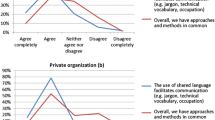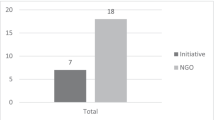Abstract
Organizing for safety and security has become increasingly complex. A multitude of actors is involved trying to respond collaboratively to problems varying from terrorist attacks to natural or man-made disasters. Interorganizational collaborative crisis and disaster management has become an essential tool to deal with multifaceted extreme events. Despite the popularity of collaboration in theory, case research has shown that it is difficult to achieve in practice. The different organizational cultures involved in interorganizational collaboration are perceived as a severe challenge to effective collaboration. This chapter asserts that a culture-as-problem approach is an unhelpful perspective. Cultural differences provide the leverage that is to be gained from collaboration and, if managed, enhance the value of collaborative activities in the field of crisis and disaster management. Increased awareness of organizational culture as an important factor in interorganizational collaboration and a focus on culture as an asset could break an important barrier to effective interorganizational collaboration during crisis or disaster.
Access this chapter
Tax calculation will be finalised at checkout
Purchases are for personal use only
Similar content being viewed by others
Notes
- 1.
Quarantelli 1998 and Perry and Quarantelli 2005 illustrate the existence of many definitions and understandings of disaster. This chapter follows the definition of Von Brainich Felth 2004. He perceives a crisis as a situation in which a vital interest is threatened and normal measures are inadequate to respond to the threat. In this understanding, a disaster is a crisis only on the terrain of the public or physical safety. This entails that disaster management is a part of crisis management, Scholtens 2008, p. 17.
- 2.
Wisner et al. 2012.
- 3.
- 4.
Kapucu et al. 2010.
- 5.
Van Twist 2000 uses this term to describe a word that has become so popular in policy debates that the use of it can count on uncritical acceptance among managers.
- 6.
Scholtens 2007.
- 7.
Scholtens 2008.
- 8.
Thomson et al. 2009, p. 25.
- 9.
- 10.
Thomson et al. 2009, p. 23.
- 11.
Thomson and Perry 2006, p. 21.
- 12.
The extensive literature on collaboration is without agreement on terms but there seems to be agreement that collaboration requires collective action on a higher level than cooperation or coordination (Thomson and Perry 2006; Alexander 1995) Most scholars agree that cooperation and collaboration are different in terms of their depth of interaction, integration, commitment, and complexity. In research and practice, coordination and collaboration have been used interchangeably.
- 13.
Thomson and Perry 2006.
- 14.
- 15.
Schein 2004.
- 16.
Ibid, p. 26.
- 17.
Barney 1986.
- 18.
Granot 1999.
- 19.
Huxham 1996, p. 4.
- 20.
Huxham 1996, p. 4.
- 21.
Huxham 1996, p. 4.
- 22.
Long et al. 2013.
- 23.
- 24.
Jackson 1996.
- 25.
- 26.
Kapucu et al. 2010, p. 19.
- 27.
Eide et al. 2012.
- 28.
Huxham 1996.
- 29.
- 30.
Scholtens 2008.
- 31.
Scholtens, p. 200.
- 32.
Scholtens 2008 for an overview of evaluations.
- 33.
Scholtens 2008.
- 34.
Scholtens, p. 202.
- 35.
Groenendaal et al. 2013.
- 36.
Meyerson et al. 1996.
- 37.
- 38.
- 39.
Wolbers and Boersma 2013.
- 40.
Wolbers and Boersma 2013.
- 41.
Wolbers and Boersma 2013 refer to this process as ‘collective sensemaking’.
- 42.
Thomson and Perry 2006.
- 43.
Scholtens 2008.
- 44.
Scholtens 2007.
- 45.
Boersma et al. 2009.
- 46.
Dutch Safety Regions Act 2010.
- 47.
Dutch Safety Regions Act 2010.
- 48.
- 49.
Dutch Safety Regions Act 2010.
- 50.
Dutch Safety Regions Act 2010, p. 37.
- 51.
- 52.
Groenendaal et al. 2013.
- 53.
Scholtens 2008.
- 54.
Groenendaal et al. 2013.
- 55.
Scholtens 2008.
- 56.
Helsloot 2015.
- 57.
Thomson and Perry 2006.
- 58.
Scholtens 2015.
- 59.
Wolbers and Boersma 2013.
- 60.
Wolbers et al. 2012.
- 61.
Scholtens 2008.
- 62.
- 63.
Thomson and Perry 2006.
- 64.
- 65.
- 66.
Huxham 1996.
- 67.
Scholtens 2007.
- 68.
- 69.
- 70.
- 71.
Thomson and Perry 2006.
- 72.
Treurniet et al. 2012.
- 73.
Thomson et al. 2008.
- 74.
Thomson and Perry 2006, p. 27.
- 75.
Edmunds 2006.
- 76.
Thomson and Perry 2006.
- 77.
- 78.
Huxham and Vangen 2005.
- 79.
Ansell and Gash 2008.
- 80.
Moynihan 2008.
- 81.
Schein 2004.
- 82.
Scholtens 2015.
References
Alexander ER (1995) How organizations act together: interorganizational coordination in theory and practice. Gordon and Breach Publishers, Luxembourg
Ansell C, Gash A (2008) Collaborative governance in theory and practice. J Public Adm Res Theor 18:543–571
Barney JB (1986) Organizational culture: can it be a source of sustained competitive advantage? Acad Manag Rev 11:656–665
Boersma K, Groenewegen P, Wagenaar P (2009) Emergency response rooms in action: an ethnographic case-study in Amsterdam. Proceedings of the 6th International Conference on Information Systems for Crisis Response and Management ISCRAM. Gothenburg, Sweden, pp 1–8
Bollen M (2002) Working apart together. Civiel-militaire samenwerking tijdens humanitaire operaties. Ph.D. dissertation Wageningen University, HAVEKA BV, Alblasserdam
Comfort LK (2007) Crisis management in hindsight: cognition, communication, coordination, and control. Public Adm Rev 67:189–197
Comfort LK, Kapucu N (2006) Inter-organizational coordination in extreme events: the World Trade Center attacks, September 11, 2001. Nat Hazards 39:309–327
Dutch Safety Regions Act (2010) https://www.government.nl/documents/decrees/2010/12/17/dutch-security-regions-act-part-i Accessed 15 March 2016
Edmunds T (2006) What are armed forces for? The changing nature of military roles in Europe. Int Aff 82:1059–1075
Eide AW, Halvorsrud R, Haugstveit IM, Skjetne JH, Stiso M (2012) Key challenges in multi-agency collaboration during large-scale emergency management. In: AmI for crisis management, international joint conference on ambient intelligence, Pisa, Italy
Granot H (1999) Emergency inter-organizational relationships. Disaster Prev Manag 8:21–26
Gray B (1989) Collaborating: finding common ground for multiparty problems. Jossey-Bass, San Francisco, CA
Gray B (2000) Assessing inter-organizational collaboration: multiple conceptions and multiple methods. In: Faulkner D, de Rond M (eds) Cooperative strategy: economic, business, and organizational issues. Oxford University Press, New York, pp 243–260
Groenendaal J, Helsloot I, Scholtens A (2013) A critical examination of the assumptions regarding centralized coordination in large-scale emergency situations. J Homel Secur Emerg Manage 10:113–135
Helsloot I (2008) Coordination is a prerequisite for good collaboration, isn’t it? J Contingencies Crisis Manag 16:173–176
Helsloot I (2015) De magere opbrengst van 30 jaar continue professionalisering in de rampenbestrijding in Nederland. In: Devroe E, Duchatelet A, Ponsaers P, Easton M, Moor LG, Wondergem L (eds) Zicht op first responders: Handboek bij het beheer van evenementen en noodsituaties in Nederland en België. Maklu, Antwerpen/Apeldoorn, pp 323–337
Huxham C (1996) Collaboration and collaborative advantage. In: Huxham C (ed) Creating collaborative advantage. SAGE, Thousand Oaks, pp 1–18
Huxham C, Vangen S (2005) Managing to collaborate: the theory and practice of collaborative advantage. Routledge, London
Jackson SE (1996) The consequences of diversity in multidisciplinary work teams. In: West MA (ed) Handbook of work group psychology. Wiley, New York, pp 53–76
Janssen M, Lee J, Bharosa N, Cresswell A (2010) Advances in multi-agency disaster management: key elements in disaster research. Inf Syst Front 12:1–7
Kapucu N, Garayev V (2011) Collaborative decision-making in emergency and disaster management. Int J Public Adm 34:366–375
Kapucu N, Arslan T, Collins ML (2010) Examining intergovernmental and interorganizational response to catastrophic disasters: toward a network-centered approach. Adm Soc 42:222–247
Meyerson D, Weick KE, Kramer RM (1996) Swift trust and temporary groups. In: Kramer RM, TR Tyler (eds) Trust in organizations: frontiers of theory and research. Sage, Thousand Oaks, pp 166–195
Leonard HB, Howitt AM (2010) Organizing responses to extreme emergencies: the Victorian bushfires of 2009. Aust J Public Adm 69:372–386
Leukfeldt ER, van der Straten KWC, Stol W (2007) Ter plaatse. Alledaagse samenwerking tussen de primaire hulpverleningsdiensten. Boom Juridische Uitgevers, The Hague
Long JC, Cunningham FC, Braithwaite J (2013) Bridges, brokers and boundary spanners in collaborative networks: a systematic review. BMC Health Services Research 13:158
Moynihan DP (2008) Learning under uncertainty: networks in crisis management. Public Adm Rev 68:350–365
Netten N, van Someren M (2011) Improving communication in crisis management by evaluating the relevance of messages. J Contingencies Crisis Manag 19:75–85
Ostrom E (1998) A behavioral approach to the rational choice theory of collective action. Am Polit Sci Rev 92:1–22
Perry RW, Quarantelli EL (eds) (2005) What is a disaster? New answers to old questions. Xlibris Corporation, USA
Quarantelli EL (1998) What is a disaster? Perspectives on the Question. Routledge, London
Ring PS, van de Ven AH (1994) Development processes of cooperative inter-organizational relationships. Acad Manag Rev 19:90–118
Schein EH (2004) Organizational culture and leadership. Wiley
Scholtens A (2007) Samenwerking in crisisbeheersing. Overschat en onderschat. Lectorale rede. http://www.nifv.nl/upload/117924_668_1197380114765-Lectorale_rede.pdf Accessed 14 Mar 2016
Scholtens A (2008) Controlled Collaboration in Disaster and Crisis Management in the Netherlands, History and Practice of an Overestimated and Underestimated Concept. J Contingencies Crisis Manag 16:195–207
Scholtens A (2015) Samenwerkingsstructuren bij beheer van rampen in Nederland. In: Devroe E, Duchatelet A, Ponsaers P, Easton M, Gunther Moor L, Wondergem L (eds) Zicht op first responders: Handboek bij het beheer van evenementen en noodsituaties in Nederland en België. Maklu, Antwerpen/ Apeldoorn, pp 103–117
Thomson, AM (2001) Collaboration: meaning and measurement. Ph.D. dissertation, Indiana University, Bloomington
Thomson AM, Perry JL (2006) Collaboration processes: inside the black box. Public Adm Rev 66:20–32
Thomson AM, Perry JL, Miller TK (2008) Linking collaboration processes and outcomes: foundations for advancing empirical theory. In: Bingham LB, O’Leary R (eds) Big ideas in collaborative public management. ME Sharpe Publishers, Armonk, New York, pp 97–120
Thomson AM, Perry JL, Miller TK (2009) Conceptualizing and measuring collaboration. J Public Adm Res Theor 19:23–56
Treurniet W, van Buul-Besseling K, Wolbers J (2012) Collaboration awareness—a necessity in crisis response coordination. Simon Fraser University, Vancouver Canada
Van Twist M (2001) De corrosie van het begrip corridor. Producten, projecten en processen. Berenschot Procesmanagement, Den Haag, pp 47–49
Von Brainich Felth ET (2004) Het systeem van crisisbeheersing. Boom Juridische Uitgevers, Den Haag
Waugh WL, Streib G (2006) Collaboration and leadership for effective emergency management. Public Adm Rev 66:131–140
Wisner B, Gaillard JC, Kelman I (eds) (2012) Handbook of hazards and disaster risk reduction and management. Routledge, New York, London
Wolbers JJ, Boersma K, de Heer J (2012) Netcentrisch werken in ontwikkeling. Een cultuuronderzoek naar multidisciplinaire samenwerking en gezamenlijke operationele beelden in de Veiligheidsregio’s. http://keesboersma.com/wp-content/uploads/2012/05/Netcentrisch_Werken_inontwikkeling_def.pdf. Accessed 14 Mar 2016
Wolbers JJ, Boersma FK (2013) The common operational picture as collective sensemaking. J Contingencies Crisis Manag 21:186–199
Author information
Authors and Affiliations
Corresponding author
Editor information
Editors and Affiliations
Rights and permissions
Copyright information
© 2016 T.M.C. Asser press and the authors
About this chapter
Cite this chapter
de Jong, H. (2016). Interorganizational Collaboration in Crisis and Disaster Management: The Valuable Asset of Organizational Culture. In: Beeres, R., Bakx, G., de Waard, E., Rietjens, S. (eds) NL ARMS Netherlands Annual Review of Military Studies 2016. NL ARMS. T.M.C. Asser Press, The Hague. https://doi.org/10.1007/978-94-6265-135-7_11
Download citation
DOI: https://doi.org/10.1007/978-94-6265-135-7_11
Published:
Publisher Name: T.M.C. Asser Press, The Hague
Print ISBN: 978-94-6265-134-0
Online ISBN: 978-94-6265-135-7
eBook Packages: Law and CriminologyLaw and Criminology (R0)





